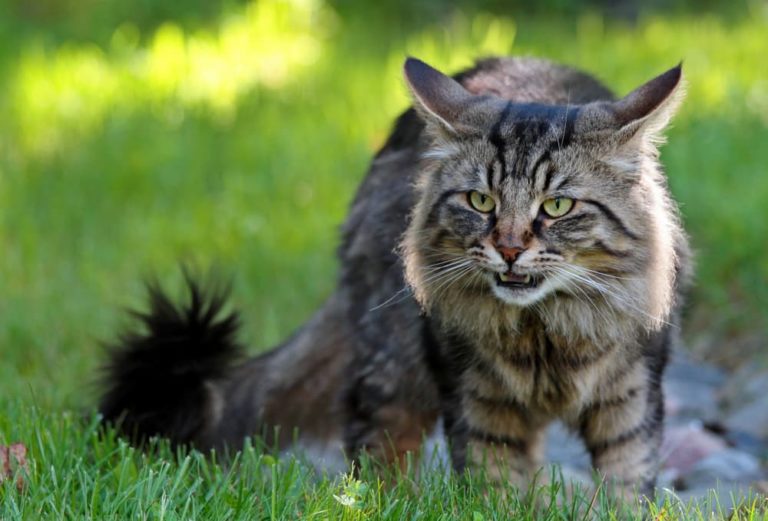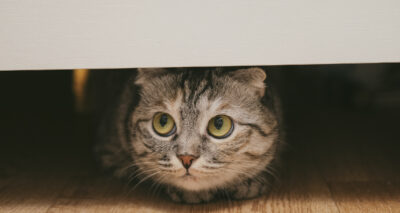Flehmen Response in Cats: All About Cat Sneering

It almost looks like a sneer. Your cat will open her mouth, curl her upper lip, and bare her incisors. Then she’ll make a funny face. If you see your cat doing this, you’re probably watching a flehmen response.
Samantha Bell, a cat expert at Best Friends Animal Society, a leading animal welfare organization in the U.S., says the flehmen response in cats is like “smelling in super hi-res.”
That’s because this behavior activates numerous receptors in cats’ mouths that put their sense of smell into overdrive.
So how do flehmen responses in cats work? And why do cats make these funny, sneering faces in the first place?
What Is the Flehmen Response?
Dr. Gabrielle Fadl, director of primary care of Bond Vet, says that cats use flehmen response to gather information.
“Cats learn a lot about the world around them by scent, and the flehmen response helps them ‘read’ even more scents and pheromones,” she says.
Bell says that cats acquire this scent-derived information by “opening two tiny ducts on the roof of their mouth behind their front teeth.”
“Those ducts go through the roof of their mouth and connect to the Jacobson’s organ,” says Bell.
The Jacobson’s organ, also known as the vomeronasal organ, is located between a cat’s hard palate and nasal septum, with tubes that run to the nasal passages and mouth.
In his book Cat Sense, cat expert John Bradshaw says the vomeronasal organ is packed with chemical receptors that allow cats to process scent differently than if they smelled through their nose.
Humans do not have this same ability, but Bradshaw says the vomeronasal organ’s function “lies somewhere between our senses of smell and taste.”
“Appreciating how cats make use of this faculty requires a leap of imagination,” he writes in his book.
Bradshaw adds that cats likely process a wide range of smells since their vomeronasal organ contains at least 30 different receptors. Dogs, on the other hand, only have nine.
While humans cannot generate a flehmen response, other animals besides domestic cats can.
“This flehmen response is very common in the animal world,” says Bell. “It’s most often seen in domestic cats and horses. But giraffes, goats, llamas, hedgehogs, rhinos, pandas, big cats like lions and tigers, and many other animals do it, too!”
Cat Flehmen Response: What Does It Look Like?

Cat flehmen response is frequently called cat sneering. Yet Bell says it looks more like a grimace than a sneer.
“A sneer usually has one side of the lip raised, and this face has the whole lip up,” she says. “I know a lot of people call it ‘stink face.’”
Specific body language often accompanies a flehmen response in cats. For instance, Bell says it usually happens when cats raise their heads after looking down to sniff something.
“The cat’s head goes from down (while sniffing) to up, sometimes held high, while exhibiting the flehmen response,” she says. “They also look like they’re in a daze for a couple of seconds while their body works to investigate the scent.”
Dr. Fadl describes the flehmen response in cats another way—“as if they’ve just smelled something stinky.”
However, she adds that cats are not “expressing an opinion on what they’ve just smelled,” but making that funny face to “boost their detection of scents and pheromones.”
Most people find cat flehmen responses quite amusing, too. “I laugh every time I see it!” says Bell.
What Does the Cat Flehmen Response Mean?
In Cat Sense, Bradshaw says that cats use their vomeronasal organ to “detect the smells of other cats.”
“Male cats perform it after sniffing urine marks left by females, including during courtship, and female cats will do the same toward urine marks left by tomcats, although only if the tom is not present,” he writes.
Bell says that male cats display this behavior more often than females, likely because they’re sniffing out chemical substances called pheromones that give information about mating. She says that even neutered males are known to show the flehmen response.
Based on her experience, Bell also says that some cats seem to display the flehmen response more than others, but she isn’t aware of any scientific research to explain this.
“One of my cats does it daily (usually after sniffing his brother’s butt), and I’ve never seen the other one do it,” she says.
Dr. Fadl says that a cat may exhibit the flehmen response more regularly due to anxiety about a potential threat in their environment. Or, she says it could be a “signal of concern for a different cat in the household.”
“For example, maybe another cat in the home suddenly starts urinating inappropriately, which might be due to a urinary, kidney, or other health problem,” she says. “The cat that smells their housemate’s urine might exhibit flehmen as a response.”
What to Do About the Cat Flehmen Response
Is a flehmen response a cause for concern? Bell says it isn’t.
“It’s a perfectly normal part of being a cat and just means they’re quite curious about the world around them,” she says.
However, consult your veterinarian if you notice your cat breathing with an open mouth and you’re doubtful whether it’s a flehmen response. In some cases, this behavior could be a sign of upper respiratory distress, says Bell.
Dr. Fadl agrees that while flehmen response isn’t usually a cause for concern, you should consult your veterinarian if you notice any unusual or sudden behavior change in your cat.
“It’s important to ensure it actually is a flehmen response and not a symptom of illness that might look similar,” she says. “For example, a cat with nasal irritation or a respiratory infection might draw their face up in a similar way, especially right before sneezing. Any additional symptoms besides just flehmen (for example, inappetence, changes to body weight or bathroom habits, sneezing or coughing, etc.) should prompt a veterinary visit, too.”
But if your cat is indeed displaying a flehmen response, take a moment to be amazed. Your feline companion is experiencing smell in a way you never would be able to.
And let’s admit it—it’s also quite funny to see your cat curl her lip and display that good ‘ole stink face.









